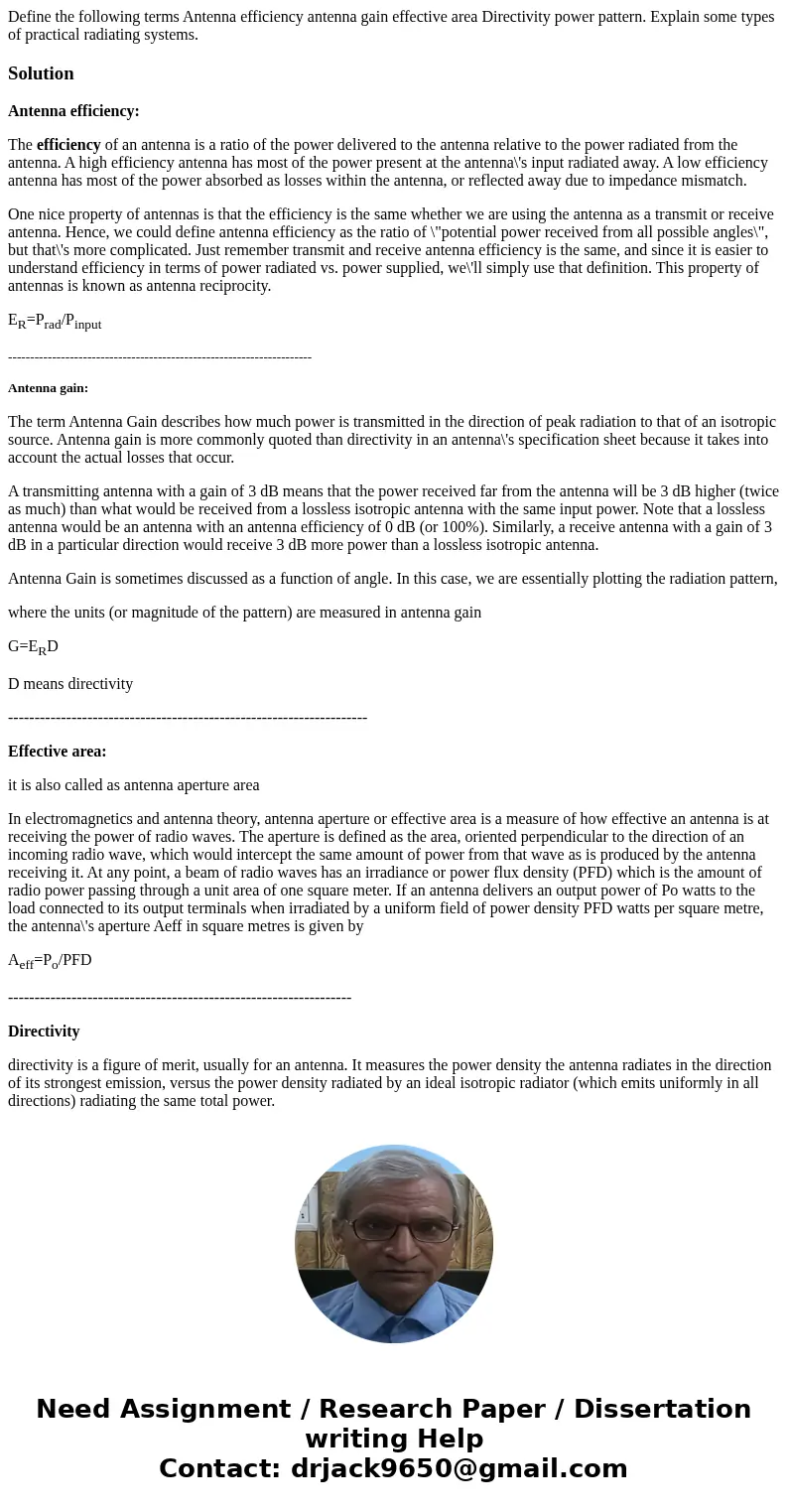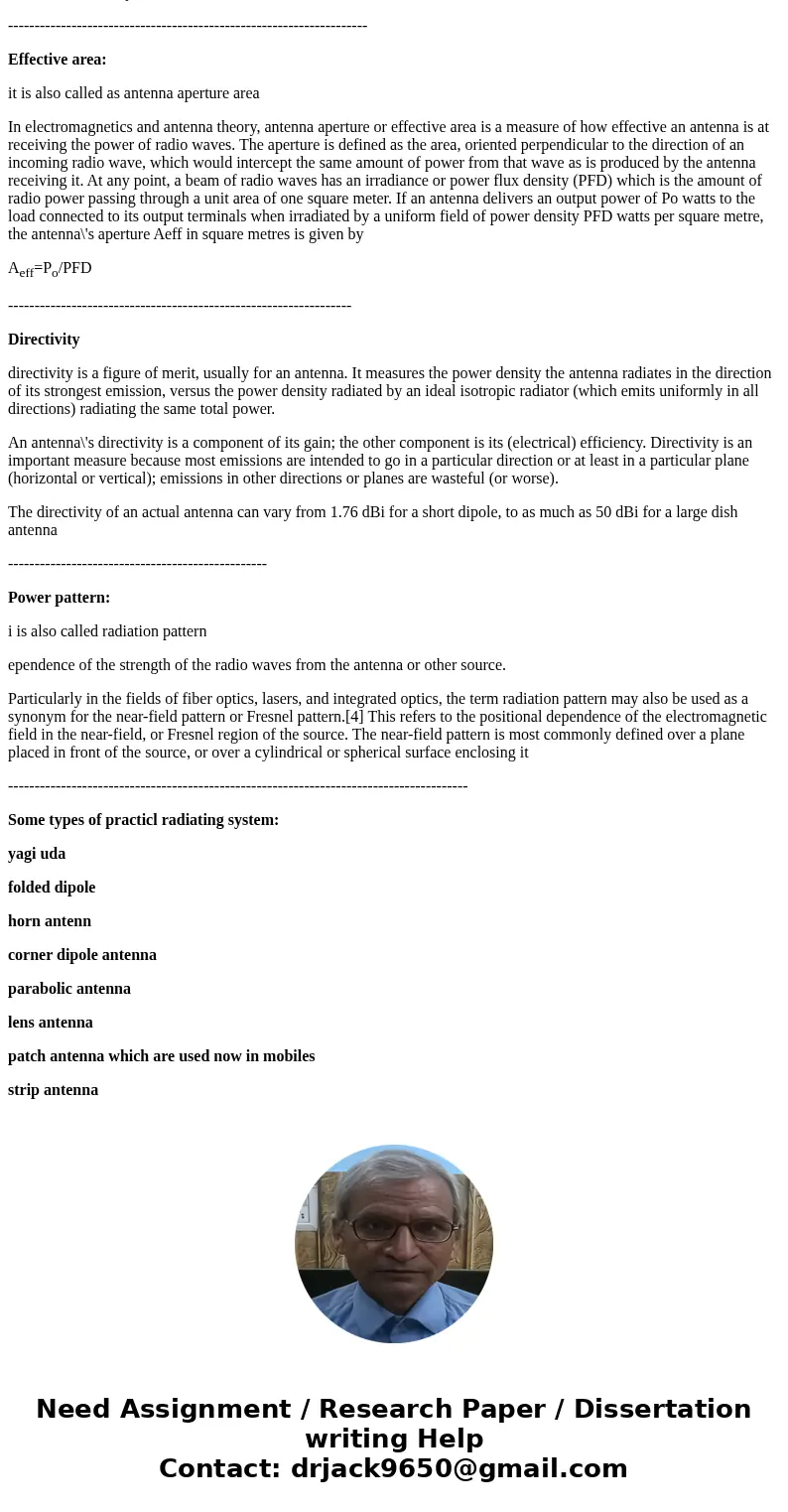Define the following terms Antenna efficiency antenna gain e
Solution
Antenna efficiency:
The efficiency of an antenna is a ratio of the power delivered to the antenna relative to the power radiated from the antenna. A high efficiency antenna has most of the power present at the antenna\'s input radiated away. A low efficiency antenna has most of the power absorbed as losses within the antenna, or reflected away due to impedance mismatch.
One nice property of antennas is that the efficiency is the same whether we are using the antenna as a transmit or receive antenna. Hence, we could define antenna efficiency as the ratio of \"potential power received from all possible angles\", but that\'s more complicated. Just remember transmit and receive antenna efficiency is the same, and since it is easier to understand efficiency in terms of power radiated vs. power supplied, we\'ll simply use that definition. This property of antennas is known as antenna reciprocity.
ER=Prad/Pinput
---------------------------------------------------------------------
Antenna gain:
The term Antenna Gain describes how much power is transmitted in the direction of peak radiation to that of an isotropic source. Antenna gain is more commonly quoted than directivity in an antenna\'s specification sheet because it takes into account the actual losses that occur.
A transmitting antenna with a gain of 3 dB means that the power received far from the antenna will be 3 dB higher (twice as much) than what would be received from a lossless isotropic antenna with the same input power. Note that a lossless antenna would be an antenna with an antenna efficiency of 0 dB (or 100%). Similarly, a receive antenna with a gain of 3 dB in a particular direction would receive 3 dB more power than a lossless isotropic antenna.
Antenna Gain is sometimes discussed as a function of angle. In this case, we are essentially plotting the radiation pattern,
where the units (or magnitude of the pattern) are measured in antenna gain
G=ERD
D means directivity
--------------------------------------------------------------------
Effective area:
it is also called as antenna aperture area
In electromagnetics and antenna theory, antenna aperture or effective area is a measure of how effective an antenna is at receiving the power of radio waves. The aperture is defined as the area, oriented perpendicular to the direction of an incoming radio wave, which would intercept the same amount of power from that wave as is produced by the antenna receiving it. At any point, a beam of radio waves has an irradiance or power flux density (PFD) which is the amount of radio power passing through a unit area of one square meter. If an antenna delivers an output power of Po watts to the load connected to its output terminals when irradiated by a uniform field of power density PFD watts per square metre, the antenna\'s aperture Aeff in square metres is given by
Aeff=Po/PFD
-----------------------------------------------------------------
Directivity
directivity is a figure of merit, usually for an antenna. It measures the power density the antenna radiates in the direction of its strongest emission, versus the power density radiated by an ideal isotropic radiator (which emits uniformly in all directions) radiating the same total power.
An antenna\'s directivity is a component of its gain; the other component is its (electrical) efficiency. Directivity is an important measure because most emissions are intended to go in a particular direction or at least in a particular plane (horizontal or vertical); emissions in other directions or planes are wasteful (or worse).
The directivity of an actual antenna can vary from 1.76 dBi for a short dipole, to as much as 50 dBi for a large dish antenna
-------------------------------------------------
Power pattern:
i is also called radiation pattern
ependence of the strength of the radio waves from the antenna or other source.
Particularly in the fields of fiber optics, lasers, and integrated optics, the term radiation pattern may also be used as a synonym for the near-field pattern or Fresnel pattern.[4] This refers to the positional dependence of the electromagnetic field in the near-field, or Fresnel region of the source. The near-field pattern is most commonly defined over a plane placed in front of the source, or over a cylindrical or spherical surface enclosing it
---------------------------------------------------------------------------------------
Some types of practicl radiating system:
yagi uda
folded dipole
horn antenn
corner dipole antenna
parabolic antenna
lens antenna
patch antenna which are used now in mobiles
strip antenna


 Homework Sourse
Homework Sourse